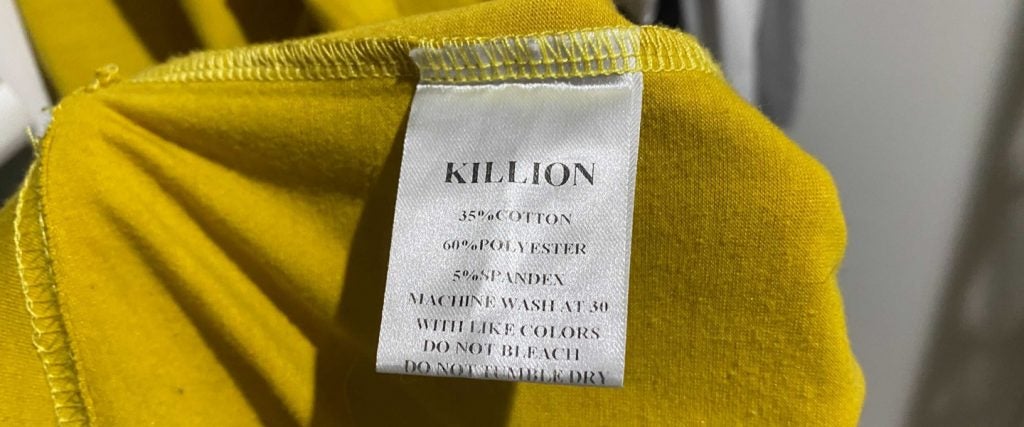In terms of clothes, figuring out what constitutes quality is complicated. Sure, you could opt for heritage brands — until you realize that heritage is now a catch-all term that doesn’t mean quality the way it once did.
Further complicating things, as one Redditor writes on the Male Fashion Advice (MFA) subreddit, is that unlike cars, which have metrics for quality like safety, speed and torque, “there are no easy metrics for clothing which could go on a spec sheet because there are a lot of factors, and it requires knowledge compared to other marketing tactics which amount to, ‘This bigger. This faster. This more,’ which people are used to.”
In other words, he continues, it’s much harder to assess why one cotton T-shirt is better than another cotton T-shirt when they functionally do the same thing.
Nonetheless, there are a few ways to at least avoid being fooled by the poser brands trying to market themselves as quality when they’re hardly any different than the fast-fashion mall brands (with the biggest difference probably being that they’re just better at marketing).
Don’t Pay Attention to Fabric Weight
Some might argue that there are ways to know which brands make better clothes based on facets like hand-sewn seams, fabric weight or GSM (grams per square meter). “Companies with better products will often give more info about their fabrics,” one MFAer tells me. “If you see things like fabric weight, origin or weave type, it’s probably nicer than just ‘100-percent cotton.’”
But fabric weight can also be misleading. “The only place I think it makes sense is in raw denim, when the denim weight gives a good indication,” another MFA subscriber explains. Otherwise, he says, weight and GSM are merely preferences that are largely “meaningless for how clothes look and feel.”
“Made In” Labels Are Bullshit
It can be tough to ignore the old notion that clothes made in China are of lower quality than those made in Italy. But you should. Yes, it’s true that China produces a lot of low-quality goods and that many high-end ones are produced in Europe. “At the same time, I have many Chinese-made garments — such as sweaters by RRL and Phillip Lim, as well as outerwear by Nanamica — that are much nicer than many Western-European-made things,” writes Derek Guy for Put This On. “Country-of-origin tags are sometimes helpful in determining quality, but one shouldn’t read the whole story off of a label (especially when the garment is right there in front of you, and you can look at much more real and reliable dimensions of quality).”
More importantly, with the globalization of fashion supply chains, many brands have products that touch multiple continents, let alone countries. A good example of this, per another MFA subscriber, is the brand Asket and their attempt to make their whole supply chain more transparent. “One garment spans the globe — from the U.S. to India to Italy to Portugal to China,” the subscriber explains. “You can imagine that other brands have similar supply chains, but all of that is lost when it’s all distilled down into one Made in X label.”
(Sometimes) Avoid Synthetics
A rule of thumb is that fast-fashion companies use synthetics as cost-cutting measures because their business model relies on low prices. As such, most garments that are made from a blend of synthetic materials (e.g., acrylics, elastane, polyester and nylon) are more often than not doomed from the start.
But again, there are exceptions to the rule — an argument best made by an MFA subscriber who points out that some designers like Issey Miyake use 100-percent polyester in their clothes and still charge hundreds of dollars for them. “Completely absurd right?” he writes. “However, let’s refer back to the fact that polyester retains its shape very well. The whole purpose of [Miyake’s] Pleats Please line is the delicate pleating found on each garment to produce an architectural effect. This would not be possible using natural materials like cotton or wool because those fibers are not as structured. Any pleating in the original garment would disappear after use, which entirely defeats the purpose.”
The TL;DR version: When designers use synthetics, it’s typically about feel and drape, not merely cutting costs — and therefore, it’s anything but cheap.
Prepare for Trial and Error
As another MFAer sums it up, “Quality is an ephemeral thing.” And so, what one person perceives as being quality someone else may not. “People expect expensive or luxury items to be extremely hardy, but this is not, nor has it ever been, the case,” the MFAer continues. “Things like fabric weight and composition are at best proxies that don’t capture everything.” Which is why, he says, “I personally prefer to shop in person whenever possible, or otherwise depend on the reviews of trusted sources.”
Basically, the best way to assess a brand’s quality is to buy something from them that you like and wait and see how it holds up. “It takes time to learn, and that also might include some costly trial-and-error,” another MFAer tells me.
“I recognize that’s not what anyone wants to hear when they’re putting their money on the line,” he admits. “But it’s the one incontrovertible truth in such matters.”

